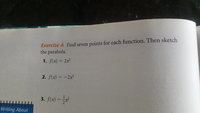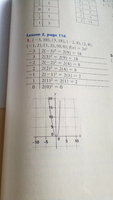Finding points for F(x)=2x^2 … Do I substitute any number I want for x or is it specific? …
Hi Cbrock. First, a note about notation. Names in math are case-sensitive, so F and f are two different names. It's best to use names and symbols as given in the exercise, so write f(x) instead of F(x) because those two symbols represent different functions.
Yes, you're free to choose any values for x, but, when graphing the behavior of a function, we generally want to show the interesting part(s), so the x-values must be chosen accordingly. For the exercises you posted, using the book's suggestion of x={-3,-2,-1,0,1,2,3} for the seven points will work because they will show each curve in the vicinity of the parabola's vertex.
Here's a different function, where the book's x-values would not be a good choice (because we wouldn't see the vertex, if we used them):
g(x) = 2x^2 - 64x + 512
In this case, we would want to pick three x-values around each side of the vertex, like x={10,12,14,16,18,20,22}. We could first use the formula x=-B/(2A) to find the x-value
at the vertex (16) and then pick other values on each side.
In case you're not familiar with function notation f(x), I'll talk about it. The symbol f(x) is a different way to write the dependent variable y. This function notation is more helpful than simply writing y. The letter f in the symbol f(x) is the function's name, so, if we happen to work with three functions at once, it's nice to name them f, g and h instead of y, y and y (which would be confusing). Also, the independent variable (or it's value) is shown inside the parentheses, so function notation provides more information than writing just y. For example:
y = 2x^2
Now, if I tell you that y=18, then you know that the y-coordinate is 18 for some point on the graph, but the associated x-coordinate is not immediately clear (that is, a value of x which makes 2x^2 equal to 18). However, if I write f(3)=18 instead, then the notation shows that x=3 leads to y=18. So, writing function notation for y, the equation f(3)=18 tells us the value of both x and y.
In the machine model of a function, symbol x represents the input and symbol f(x) represents the output. The input appears inside the parentheses, and the entire symbol -- like f(3) or f(x) -- represents the function's output.
Symbol f(x) is function notation for the
variable y (the output variable) when the input variable is x.
Symbol f(3) for example is function notation for the
constant 18 (that is, it represents the
specific number output, when the input is 3).
So this is why we say
y = f(x). The symbol y and symbols like f(x) or f(3) represent the same thing (a variable or a constant, depending on whether the x-value is specified or not).
If you're still unsure about any of this, you can google keywords
function notation, or ask if you can't find a clear explanation. Perhaps we can find some online lessons for you about function notation and the machine model of a function, in general. Otherwise, it will become clear with more practice. Cheers
?
 Please let me know if I should move it.
Please let me know if I should move it.



